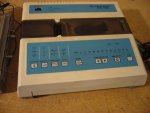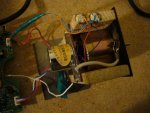I know, it has to be digitally controlled to apply some corrections. Rotating polygons are way too expensive for this project.
Maybe I can take advantage from the opposite principle: use the magnet as a mirror with an external electromagnetic field induced by a solenoid (shaped as a U) placed under it to control it, in a context similar to the one in the upper image (but reversed).
I hope you understood my idea...
If I have some time I can do a simple 3D model.
I think there will be no problem to make it oscillate at high frequencies, as it doesn't need to make a full angle of rotation but only few degrees.
Someone knows where I can find a neodymium magnet with a mirror-shaped surface? Can I use silver nitrate to turn it into a mirror?
I saw you are a university researcher, can you help me with some maths?
Thanks, Riccardo
EDIT: here the render for my idea. The U is the solenoid, which induces a EMF which actually moves the magnet (the round mirror in the center)
ANOTHER EDIT: In this other example I took two ferrite cores and a rectangular shaped neodymium mirror. Normally the mirror can rotate freely, but when an electro magnetic field is inducted by the semi-toroids the mirror has to rotate around its hub. Regulating the current flux inside the solenoids you can control mirror movements. It's important that the magnetic force is enough strong that it can overcome the moment of inertia and the friction. The two semi-toroids are slightly separated so that the laser beam can pass between them.
Can you help me mathematically find the right current function in order to have a constant angular velocity?
The realization is very inexpensive: two toroids, a rigid support, a hub, some magnet wire and the neodymium magnet (cheap on ebay, it can be bought silver or nickel coated, so it's even a good mirror). Well, it can be easily done with less than 10$.
In the rear of the machine a cheap red laser can be used with some photodiodes in order to have a feedback system


I also found a very lightweight neodymium magnet, easily turnable into a rotating mirror
https://www.hkcm.de/HKCM_datasheet.php?l=en&id=4286








